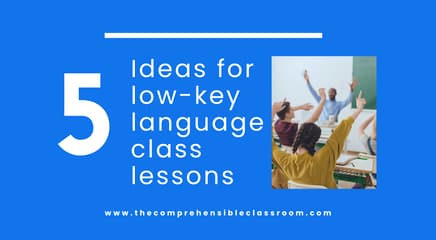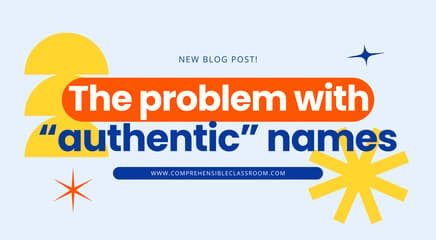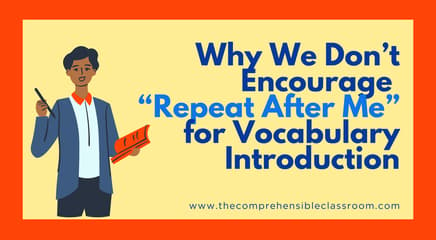Sometimes you hit a unit in the curriculum when things just drag.
You feel it. Your students feel it. Maybe it’s a specific lesson, maybe it’s an entire unit. And it’s easy to start wondering:
"Is it me? Are the kids just checked out? Am I doing something wrong?"
If you’ve been there (or you’re there right now), this is your reminder of one of the most important core mindsets we hold at The Comprehensible Classroom:
Connection over curriculum

Covering the curriculum is not the end goal: the curriculum is a springboard.
Our goal is not to "cover" content; it's connection.
You see, in acquisition-focused classes, students aren’t studying grammar and vocabulary. Instead, they’re engaging in authentic communication using whatever language they have at a given moment! They are reading, writing, listening, and speaking for social, informational, and entertainment purposes… just like they do in the world outside the classroom!
The curriculum is there as a tool to help teachers foster those connections. The activities and the content in the curriculum is there for teachers to help students:
• Connect to each other
• Connect to the world (especially but not exclusively the target culture!)
• Connect to new ideas and information
• Connect to their interests and passions (maybe by discovering new ones!)
The lesson plans we give you are suggestions, not checklists.
You are never expected to teach everything in a unit, or even every unit! You can adapt the plans. You can skip parts. You can even skip an entire unit if the Core Vocabulary is already familiar to your students. Or, you can skip a unit and expose students to the Core Vocabulary in a different way!
You are in charge, and your students' engagement is your guide. If your students aren’t interested, don’t torture yourself or them. There are infinite things you can communicate about in class, so look for something different that will spark their interest.

Example: Somos 1 Unit 4
A teacher recently asked if anyone else noticed students dragging during Somos 1 Unit 4. I originally designed this unit to be taught during University Week at my middle school in Anchorage, AK. All classes were supposed to tie higher education into their teaching in some way! As a language teacher using Acquisition Driven Instruction (ADI), I wrote a story about future plans and college and an article about universities in Spanish speaking countries. Since then, we’ve added new content that extends the unit–but it’s all centered on the theme of higher education and careers. It’s a unit that creates an opportunity for students to think about their futures and challenges stereotypes (some conscious, some unconscious!) about education and career opportunities outside the United States.
For teachers who discover that this content feels b-o-r-i-n-g to their students, here are some ideas.

Option 1: Give it a try anyway
You are the expert in your classroom, and you know your students. You may be able to determine at a glance that this unit just won’t fly with your classes. That may totally be the right call! However, I invite you to give it a try anyway; at least once. You can always bail and move on if you need to!

Option 2: Skip the unit
If your students are already comfortable interpreting most of the core vocab (wants to be, takes, speaks/talks), skip Unit 4 completely. No shame, no stress! The Core Vocabulary from Unit 4 will be used in future units, and the assumption is that students will be familiar with it and reasonably able to interpret it in context as they learn about new topics. For that reason, it is important that you do a quick gut check to make sure your students get used to interpreting those words in some way before moving on to Unit 5. Look for other opportunities to expose students to the context-specific vocabulary in the unit (careers, classes, languages) throughout the year. A really easy way to do this is through Card Talk, which is an activity that’s actually used in the unit.

Option 3: First two phases only
Do just the first two phases (Establish Meaning and Acquisition through Narrative) — and then move on, skipping the universities and careers content. These phases include a Card Talk activity about what students want to be in the future and a TPRS®-style story, and most students enjoy these elements of the unit!

Option 4: First two phases plus Stations
Do the first two phases of the unit (described above) and the Stations activity about different career paths, but skip the Universities piece. Stations are a lowkey activity that usually feel like a break from the routine for both teachers and students, so tacking on this piece might be just the right mix of content and interest!

Option 5: Change the content connection
Do the first two phases, and then pivot to a different content study in the third phase of the unit. Instead of learning about universities and careers, use the Silbo gomero lesson plans. It’s a fascinating cultural connection that students love! Silbo gomero is featured in the Flex version of Unit 4, and it’s sold as a set of standalone plans. If you have a Tesoro Membership, you have year-round access to all of our supplemental, standalone materials–so it’s easy to pivot what content you teach in any given unit! And if you have the Flex version of the curriculum, you’ll find different options for stories and informational content for nearly every unit of the program.

Option 6: Change the activities
Some teachers have shared that really small changes make a really big difference! One such example is to change the unit’s Card Talk prompt from “What do you want to be [in the future]?” to “What don’t you want to be?” (suggestion from a teacher in the Somos Collab group!), or even, “What animal do you want to be?”. Even if it requires a little vocabulary change (for example, “quisiera ser” (would want to be) instead of “quiere ser” (wants to be), you can make that switch.

Option 7: Add games!
Let’s face it: sometimes, you want to or need to cover content that students just don’t care that much about. If you really want to stick with the content of the curriculum as written, covering universities and careers, you can! Perhaps something as easy as adding in a game will boost the energy and interest. You can grab games for every unit in our Simple Sentences game packs, available for Nous sommes, Vamos, and Somos!
The bottom line is that you have options!
If a unit is dragging, remember: You’re not stuck. You’re not behind. You don’t have to be miserable. When you notice that your students are disinterested and you problem solve, you’re doing exactly what good teachers do: staying connected to your students and adjusting the path as needed.

The language in each of our titles (Somos, Vamos, Nous sommes) is cumulative, so your students will be exposed and re-exposed to core vocabulary and much context-specific vocabulary throughout the year, not just in a single unit. If a particular lesson or unit isn't sparking connection right now, that’s okay.
Listen to your students, and trust yourself. You’ve got this!




